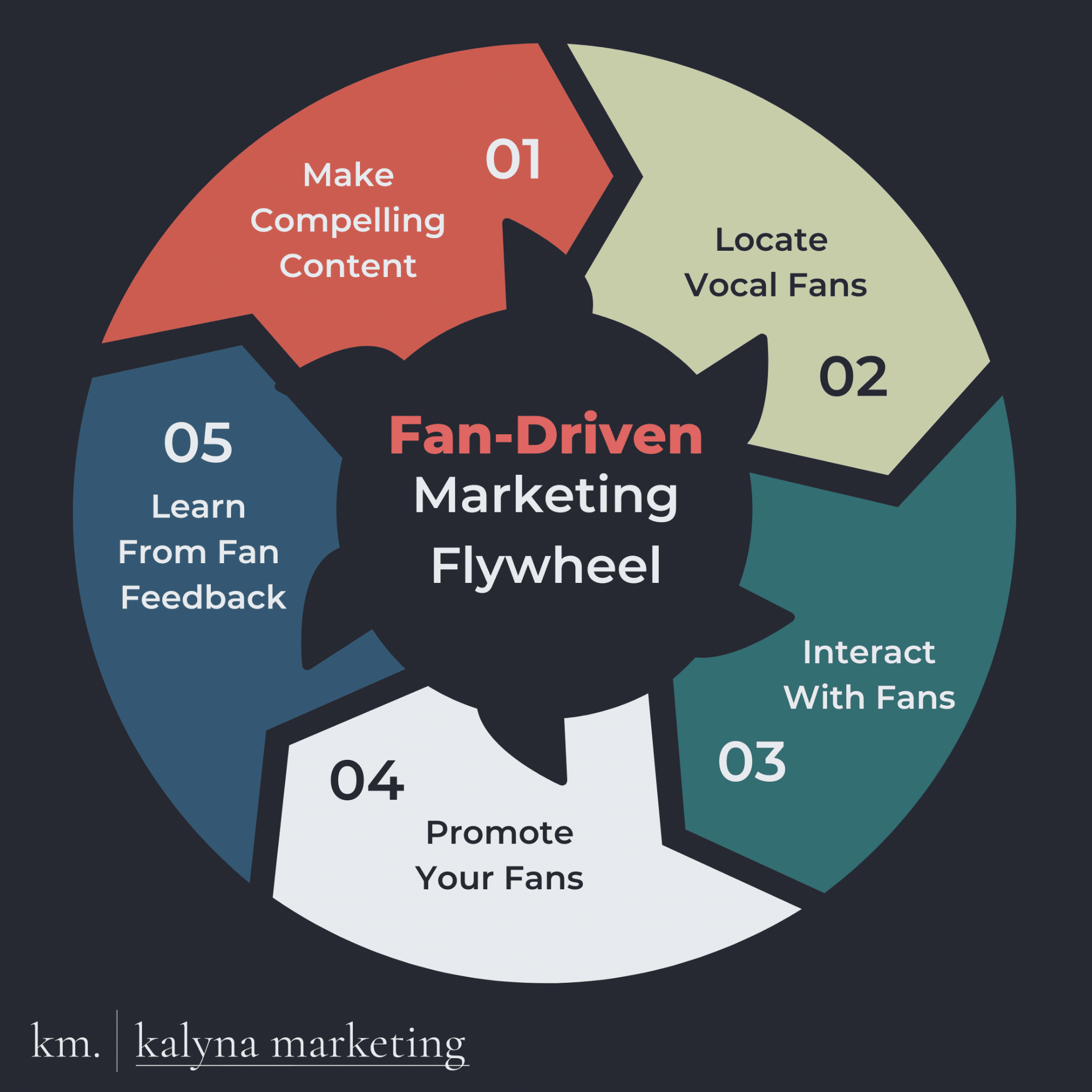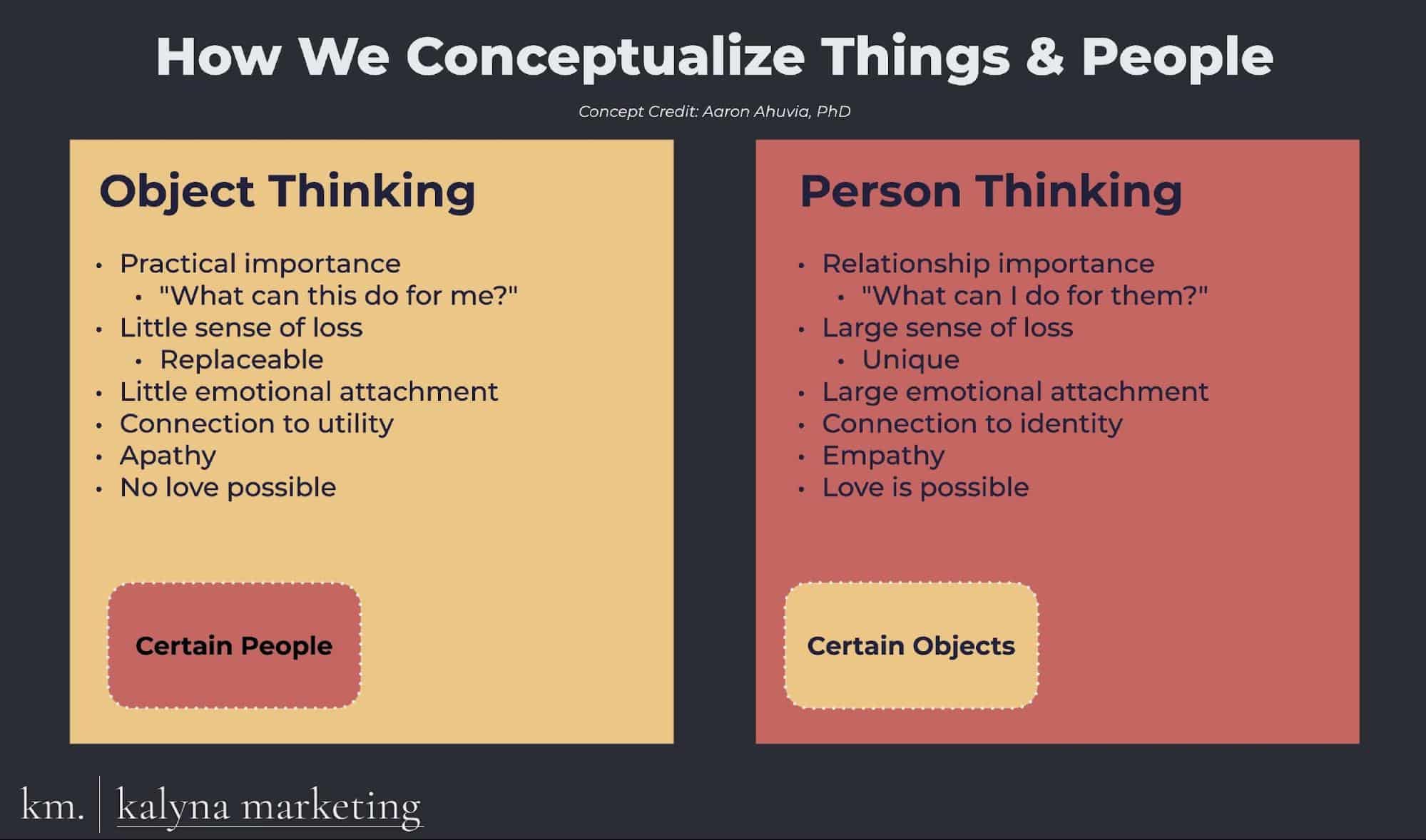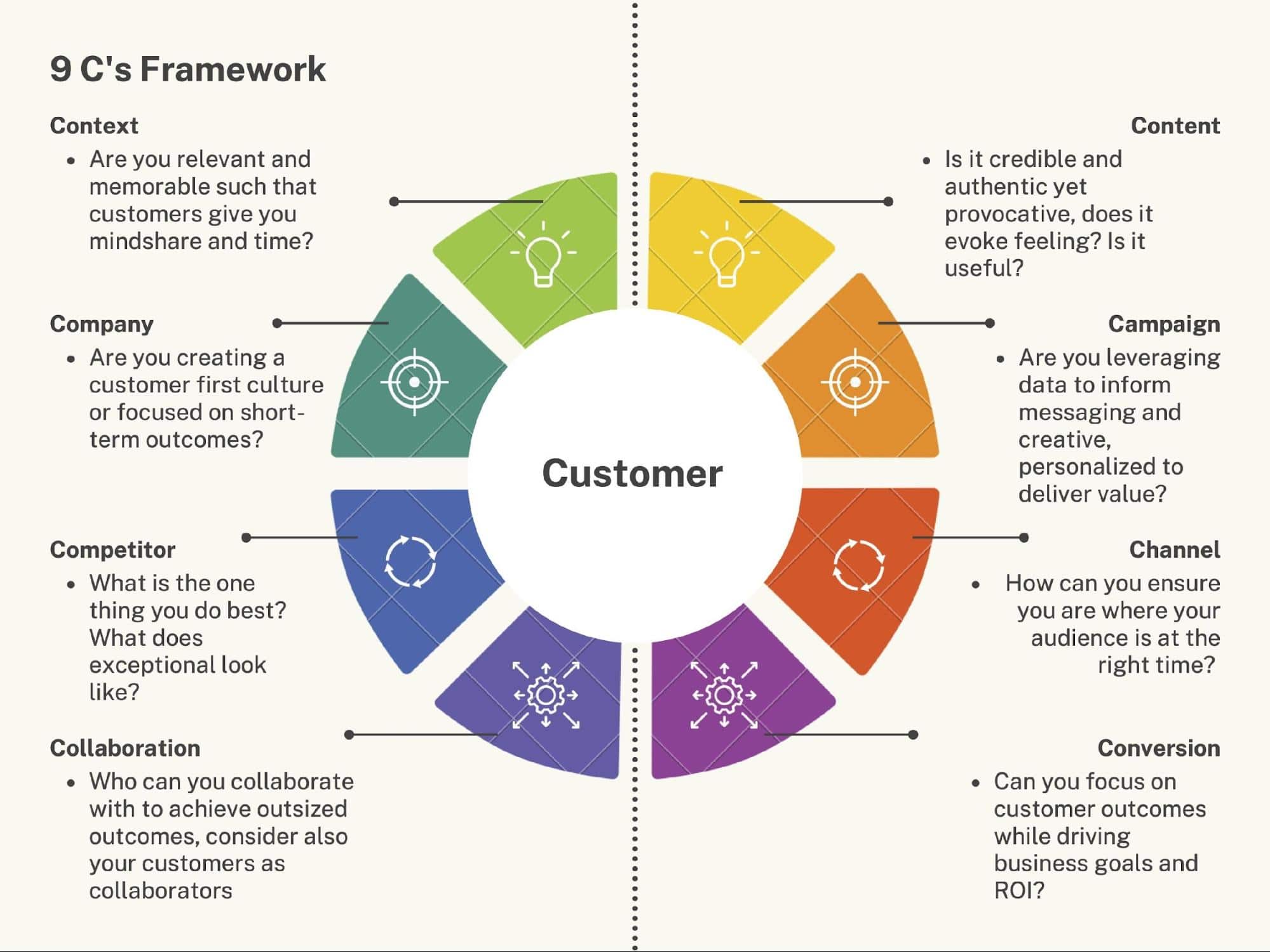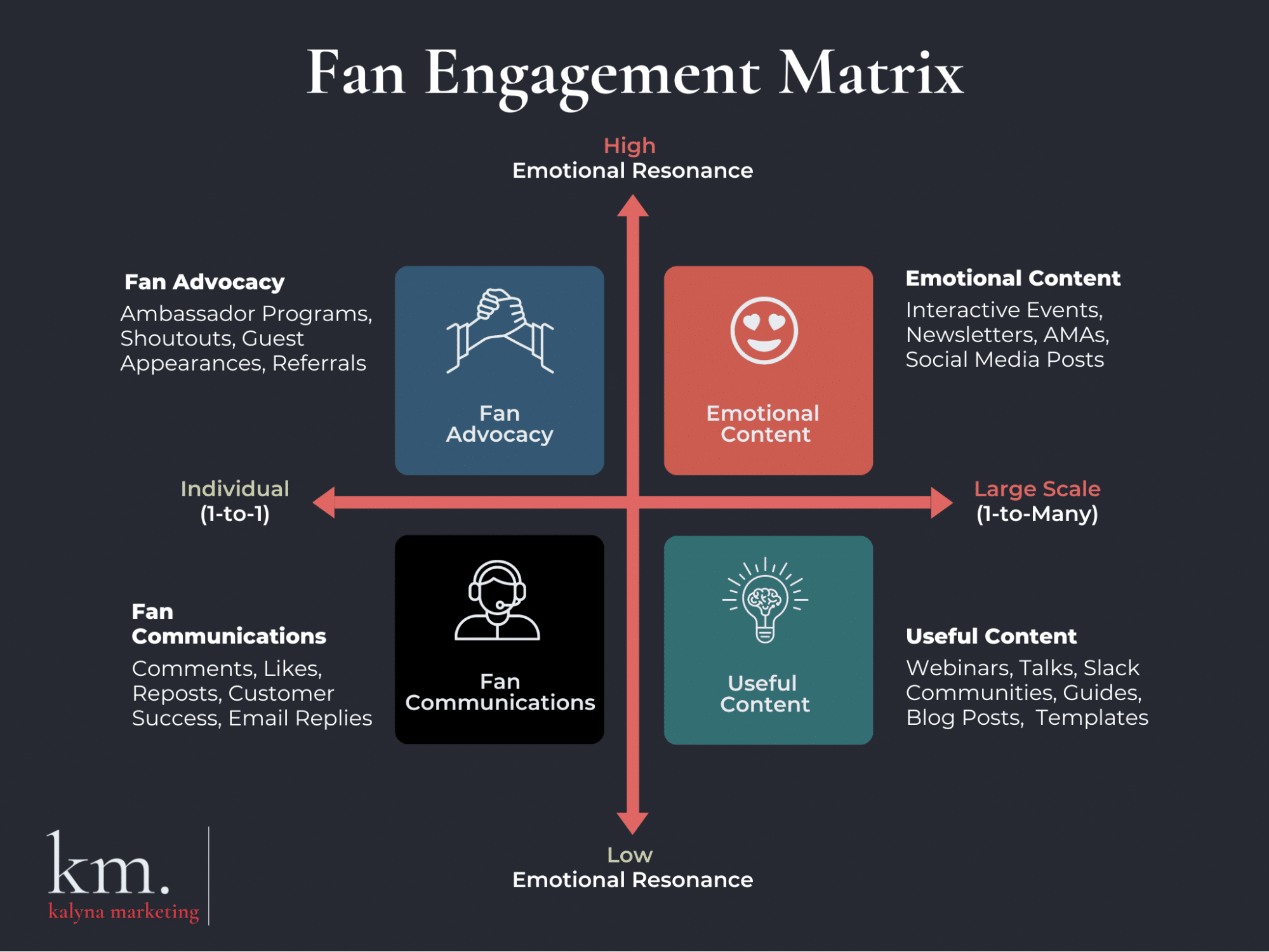Why investing in brand love and emotional attachments may be the best marketing investments that your brand can possibly make.
Who loves your brand the most?
No matter what you sell, you probably have customers who:
- Truly care about your company, products or services and content.
- Find your products valuable and also see your business as an extension of themselves.
- See their own sense of being reflected in your brand.
Sounds great, doesn’t it?
If you have fans who sincerely love your brand, they are a lot less likely to churn and leave you for a competitor. On the other hand, they are much more likely to bring you even more business – superfans often become walking marketing campaigns for things they like, spreading word of mouth as much as their connections allow them.
If engaged fans are such a significant business advantage then why aren’t most brands investing into fan-oriented campaigns?
Most businesses don’t really think about their customers (let alone their superfans) as a marketing channel. Whenever I bring this topic up with marketers, directors, or executives all across the B2B world – I get met with blank stares.
But that’s precisely why investing into marketing for and your biggest fans is the biggest growth hack you can possibly implement. Because fan advocacy is such a niche undertaking, especially in channels like content and SEO, if you actually put in an effort – you will overtake your competition in a heartbeat.
So let’s take a look at what fan-driven marketing actually is, how it returns such an outsized ROI on marketing spend and why you should incorporate it into your marketing work.
What is fan-driven marketing?
If your business has a customer community or engagement program, you’re probably feeling pretty skeptical about what I’ve said so far.
You might be sitting there thinking: ”well, yeah. There’s a reason why all of our competitors invest into customer communications. This isn’t exactly a secret.” And you would be right.
Neither “customer communications” nor “customer engagement” are particularly niche concepts in and of themselves. But most businesses stop long before those efforts could truly realize their potential.
Just because you spam your buyers with webinar links and occasionally like their LinkedIn posts from your company account doesn’t mean you actually run a customer engagement program.
Most businesses engage their customers with the sincerity of a grumpy teenager forcing a smile at a family photo. It’s fake. And everyone can tell.
If you were to truly embrace customer-centric marketing, what would it look like?
Your investments in your fans would become a flywheel. Each effort would compound on every bit of work that came before it, driving momentum across all of your marketing channels.
For SEO and content professionals, a fan-driven marketing flywheel might look something like this:


- Make some compelling content that’s targeted to your audience’s real pain points and distribute it via some mix of SEO, social, email or paid channels.
- Once people begin looking at your content, locate your vocal fans. By definition, they’re easy to find – you simply need to start paying attention.
- Now that you know who likes your brand, interact with your fans. Make them feel seen, heard and cared about. Open up those channels of communication.
- Take your communications further, and thank your fans by helping them too. Promote your vocal fans using your existing platforms and channels.
- Once you’ve been communicating with fans for some time, they’ll begin giving you feedback. Listen to them, and incorporate some of their thoughts into your new content.
My clients often ask how they can possibly figure out which of their content resonates.
Here’s a secret: if you actually let your fans talk to you and hear what they’ve got to say – audience and customer research becomes so easy.
You will always have a ready feedback loop to test engagement on any marketing initiative that you wish to run.
Why we care
All of this fan engagement might sound like a lot of work. It’s so much simpler to steal ideas from your competitors or paste keyword lists into Semrush for the 500th time that week.
Why would you bother changing your ways?
Well, let’s think about it. If your brand develops fans who are emotionally attached, love what you’re doing, and constantly tell others about you – you’ll likely begin seeing results across all of your marketing KPIs.
Here are some potential benefits from investing into your superfans:
- High-quality backlinks from organic shares.
- Content engagement across your websites, socials, and other channels.
- Brand awareness compounds via spontaneous word of mouth.
- Retention even when markets are tight, thanks to improved customer loyalty.
- User-generated content that your fans create simply because they want to.
- Higher LTV from fans who are more likely to upgrade and remain with your brand long-term.
Share this list with your stakeholders, and I’ll be shocked if they don’t see the objective business opportunity in building a fan-driven marketing program.
How do people become fans and fall in love with brands?
The concept of superfans might sound a little strange.
You might operate in what’s classically considered a “boring” vertical such as law, cybersecurity, construction or insurance. You may believe that nobody could ever see your products or services as anything more than a necessary evil or a minor nuisance. You could wonder if anyone can possibly fall in love with your brand.
In my experience, any business can inspire sincere love. It doesn’t actually matter what you sell, as long as you’re not actively scamming and misrepresenting your value proposition.
But outside of extreme exceptions, any business with some degree of product-market fit is perfect for attracting superfans.
How?
Because whether people become your fans actually has nothing to do with your brand. Their love is, first and foremost, about how your brand makes them feel. As Brittany Hodak wrote in her book about superfans:
“fandom and identity are intrinsically linked. The things we love become part of our personal stories and influence the way we see the world and everyone who lives in it. They play a role in how and why we form relationships with those around us.”
Customers love your business because of how you:
- Improve their lives.
- Connect them to others.
- Help them achieve their goals.
This works for B2C (e.g., a cyclist who buys carbon wheels to perform better in a race) or B2B (e.g., a marketer who pays for an audience research SaaS to craft better strategies for her clients – hello!).
Beyond brand loyalty: consider “brand love”
Do you want to improve brand loyalty and increase customer retention? Fostering brand love might be your fastest road to success.
“Love-based and attachment-based brand relationships are most strongly linked to customer brand loyalty.” an academic study from 2019 found. Their analysis found that brand loyalty was affected by love and attachment more than trust, time, product type, or consumer characteristics.
In other words:
You’ll improve brand loyalty more by getting customers to love you than by improving your product, getting better reviews / testimonials or targeting different market segments.
So what is this “brand love” I keep mentioning?
Take it from one of the world’s foremost experts on the topic, Dr. Aaron Ahuvia, Professor of Marketing at University of Michigan-Dearborn, who is also known as ”Dr. Brand Love”.
As Ahuvia wrote in one of his earlier papers on the subject (co-written with Rajeev Batra and Richard P. Bagozzi), brand love is made up of the following elements:
- Self–brand integration,
- Passion-driven behaviors
- Positive emotional connection
- Long-term relationship
- Positive overall attitude valence
- Attitude certainty and confidence (strength)
- Anticipated separation distress.
In other words, when people love brands they:
- Spend a lot of time and energy on it.
- Connect their sense of identity.
- Feel positive emotions.
- Feel afraid of losing that brand from their lives (or the brand’s products and services).
Brand love is a sincere and deep emotional bond, just like our love for people.
Object vs. person thinking
How do people end up feeling such intensity for inanimate objects and the organizations that make them?
Ahuvia was kind enough to grant me permission to share one of his newest frameworks that answers precisely that question. In fact, this article is the first time this model has appeared online (outside of an earlier description published in his 2022 book).
Here is my graphic summarizing his points:


Essentially, our brains process our interactions with the outside world in two distinct ways:
- Object thinking: When we interact with inanimate objects, we think of them in terms of their practical utility. An object is only important insofar as it can help us improve our own lives. For example, I like my water bottle as long as it can carry liquids without spilling.
- Person thinking: When we interact with people, we think of them as individuals with unique significance in relation to us. People are important to us because we know them, we care about them in terms of emotional attachment. For example, even if my husband decided to lie on the couch all day for the next week and not help out with the dishes, I wouldn’t just stop loving him and marry someone else.
As you might imagine, love is only possible within person thinking.
Object thinking is fundamentally selfish, almost apathetic – when an object stops serving its purpose, it gets replaced.
Love, on the other hand, requires some level of sacrifice. We often love someone almost for the sake of loving them, practicality be damned.
When modes of thinking get crossed
If you’ve been paying attention, you probably have some questions.
We’ve spent all of this time talking about the love that people have for brands. Yet, now I’m telling you that humans are only capable of loving other people, not objects.
That’s because the brains of most people tend to make some exceptions.
Every now and then, we might think of certain people as objects. We even have a term for that in the English language: objectification. When you objectify someone, you see them purely in terms of what they can do for you.
On the other hand, we might also begin to think of certain objects like people. Even when we consciously know that our favorite shirt or SaaS tool might be just an object, our brains process it like a person that we have a relationship with. We begin to feel sincere attachment, and that’s when we become capable of experiencing brand love.
Ahuvia mentions three ways in which this switch from object to person thinking can occur:
- Anthropomorphism: When objects act like humans. Think voice assistants like Siri or AI like ChatGPT.
- People connectors: When objects symbolize connections to other people. I love SparkToro because it connects me to people I like in the marketing world (both on their team and within their community).
- Sense of self: When objects expand our sense of what’s possible and connect us to our values. That’s why people get obsessed with pumpkin spice lattes – the coffee becomes a representation of comfort, relaxation and fall weather.
Why nobody loves your brand
Alright. If any brand can be loved, why does nobody love your business?
To answer that, you need to realize that the distinction between object and person thinking can be applied to marketing in two ways:
- How customers think of your brand
- How your brand thinks of its customers.
The reason why many businesses don’t have superfans is because they treat their customers purely in object terms. A buyer is simply a means to an end, adding numbers to financial reports and justifying the business’s existence.
If you only treat customers in terms of their functional utility, why are you surprised when they do the same to you?
Where have you looked for your fans?
Start at the beginning: how have you tried to find your fans?
I frequently assist B2B companies with customer and audience research, and you’d be surprised at how many businesses have never made an effort to involve customers in their marketing efforts.
We used to fight tooth and nail simply to get approval for interviews, and to this day I explain the idea behind online audience research on most discovery calls.
You might think you have no fans simply because your business never made an effort to look for them. When people feel like talking to you is about as effective as squirting Gatorade at a wildfire, they will stop trying to connect with you.
Think about it. How many fans have you missed out on because you ignored the people who cared about your brand?
Maslow’s hierarchy of customer care
You might fall into a different trap when you try to interact with fans. Not all customer interactions and fan engagements are equally meaningful.
- “Even when they delight, or try to take care of their fans, their efforts are very singular. Like, it’ll be swag. And usually they pat themselves on the back. And yes, I think they’ve done a great job. But that isn’t how everyone likes to be loved or have their love returned,” Christina Garnett, HubSpot’s principal marketing manager of offline community and advocacy, told me.
Garnett strongly believes in building up customer care efforts by meeting different types of customer needs. She created her own version of Maslow’s Hierarchy of needs to illustrate what those levels of engagements look like:


If you want superfans who truly love your brand and promote it, you need to go beyond meeting their needs for a functional product (survival) or basic support (safety).
While efforts like creating swag of acknowledgment on social media to get into meeting a need for love or belonging, true attachment requires you to help customers feel important (esteem) and get better at the things they care about (self-actualization).
In B2B, the best way to make customers truly love you is to help them improve in their own jobs. Just as you are trying to grow the business you work for, your customers are individuals or teams that want to grow their own organizations. So consider how you can help them reach their potential with your marketing efforts.
How to implement fan-driven marketing
Now you’re ready to implement some tactics to create, nurture and empower your superfans.
Measure brand love
How do you create benchmarks around something as nebulous as emotional attachment? After all, your stakeholders won’t be satisfied with pure speculation.
Thankfully, there is a way to objectively measure brand love. You can run surveys or interviews that ask customers questions about their emotional investment in your brand, such as:
- To what extent do you feel that using [Product] says something “true” and “deep” about who you are as a person?
- Is [Company] an important part of how you see yourself?
- Does [Product]contribute something towards making your life worth living?
- How frequently do you find that [Company] keeps popping into your head?
- Do you feel there is a natural “fit” between you and [Product]?
To help you incorporate a quantifiable scale of brand love into your marketing mix, I’ve adapted the questions above and more of Ahuvia’s work into a custom Notion template.
Put your customers first
To transition from fan-driven marketing strategy to actionable tactics, I’d like to introduce you to a framework made by Sophia Agustina, global brand-to-demand strategy at IBM.
Agustina allowed me to be the first to publish this graphic that she crafted in collaboration with Margaret Safford, head of US community at greyhairworks!


As you can find above,the 9C’s framework combines 8 different concepts to center the customer at the core of your marketing campaigns:
- Context: Are you relevant and memorable such that customers give you mindshare and time?
- Company: Are you creating a customer-first culture or focused on short-term outcomes?
- Competitor: What is the one thing you do best? What does exceptional look like for your brand?
- Collaboration: Who can you collaborate with to achieve outsized outcomes (consider your customers are also collaborators)?
- Content: Is it credible and authentic yet provocative, does it evoke feeling? Is it useful?
- Campaign: Are you leveraging data to inform messaging and creative, personalized to deliver value?
- Channel: How can you ensure you are where your audience is at the right time?
- Conversion: Can you focus on customer outcomes while driving business goals and ROI?
By answering these questions and using all of your marketing campaigns to prioritize your customers and your needs, you can foster brand love in a sustainable and strategic way.
Meet practical and emotional needs of your fans


If you’d like to fulfill both practical (e.g., safety, self-actualization) and emotional (e.g., belonging, esteem) needs of your customers, consider categorizing your marketing activities into the following buckets:
- Fan communication: Speak with your customers one-on-one via customer support, social media engagement and other practical communications.
- Fan advocacy: Expand past communication and engage customers one-on-one on a more emotional level by advocating for their interests and success via promotion and collaborations.
- Useful content: Create useful content that helps your customers improve their skills at scale.
- Emotional content: Create content that fosters parasocial attachment by allowing your customers to see the human side to your business and people within your organization.
As with any tactic, the most effective combination of fan engagements will change from one business to another. But at its core, each marketing activity needs to be customer-centric and drive business ROI through a relentless focus on customer outcomes.
What next?
When you put in an effort to help your biggest fans, they will help you 10 times more.
Yes, targeting something as subjective as brand love can be scary. You’re messing with people’s deep emotional attachments, and there are plenty of risks to getting that wrong. But as with any meaningful relationship, love is usually worth it.
So show your customers that you care about them becoming your fans. And demonstrate that you love them as much as they are starting to love you.
Opinions expressed in this article are those of the guest author and not necessarily Search Engine Land. Staff authors are listed here.
Related stories
New on Search Engine Land
@media screen and (min-width: 800px) {
#div-gpt-ad-3191538-7 {
display: flex !important;
justify-content: center !important;
align-items: center !important;
min-width:770px;
min-height:260px;
}
}
@media screen and (min-width: 1279px) {
#div-gpt-ad-3191538-7 {
display: flex !important;
justify-content: center !important;
align-items: center !important;
min-width:800px!important;
min-height:440px!important;
}
}
googletag.cmd.push(function() { googletag.display(‘div-gpt-ad-3191538-7’); });
–>
Original Source: How to use fan-driven marketing to foster brand love